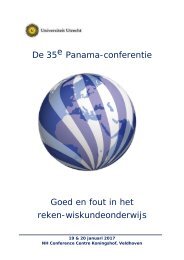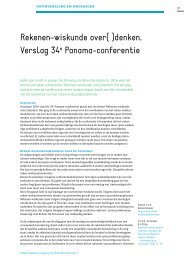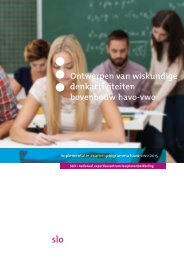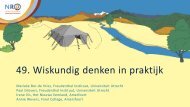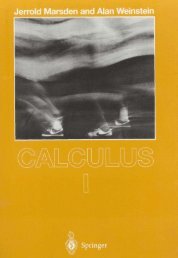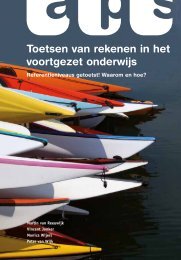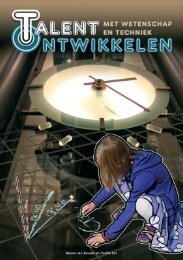You also want an ePaper? Increase the reach of your titles
YUMPU automatically turns print PDFs into web optimized ePapers that Google loves.
2006 Vol. 38 (2) Analyses<br />
1. MESSY REAL WORLD SITUATION REAL WORLD PROBLEM STATEMENT:<br />
1.1 Clarifying context of problem [ACTING OUT, SIMULATING, REPRESENTING, DISCUSSING PROBLEM SITUATION]<br />
1.2 Making simplifying assumptions [RUNNERS WILL MOVE IN STRAIGHT LINES]<br />
1.3 Identifying strategic entit(ies) [RECOGNISING LENGTH OF LINE SEGMENT AS THE KEY ENTITY]<br />
1.4 Specifying the correct elements of strategic entit(ies) [IDENTIFYING SUM OF THE TWO CORRECT LINE SEGMENTS]<br />
2. REAL WORLD PROBLEM STATEMENT MATHEMATICAL MODEL:<br />
2.1 Identifying dependent and independent variables for inclusion in algebraic model [TOTAL RUN LENGTH AND<br />
DISTANCE OF STATION FROM CORNER]<br />
2.2 Realising independent variable must be uniquely defined [CANNOT USE X FOR DISTANCE FROM BOTH A & B]<br />
2.3 Representing elements mathematically so formulae can be applied [TOTAL LENGTH EXPRESSED IN TERMS OF<br />
EDGE DISTANCES ALONG THE FIELD]<br />
2.4 Making relevant assumptions [PYTHAG. TH. IS APPROPRIATE GIVEN STRAIGHT LINE APPROXIMATIONS TO PATHS]<br />
2.5 Choosing technology/mathematical tables to enable calculation [RECOGNISING HAND METHODS IMPRACTICAL]<br />
2.6 Choosing technology to automate application of formulae to multiple cases [LISTS HANDLE MULTIPLE X-VALUES]<br />
2.7 Choosing technology to produce graphical representation of model [SPREADSHEET OR GRAPHING CALCULATOR<br />
WILL GENERATE PLOT OF L FOR DIFFERENT X-VALUES]<br />
2.8 Choosing to use technology to verify algebraic equation [RECOGNISING GRAPHING CALCULATOR FACILITY TO<br />
GRAPH L VERSUS X]<br />
2.9 Perceiving a graph can be used on function graphers but not data plotters to verify an algebraic equation<br />
[GRAPHING CALCULATOR CAN PRODUCE GRAPH OF FUNCTION TO FIT POINTS – SPREADSHEET CANNOT]<br />
3. MATHEMATICAL MODEL MATHEMATICAL SOLUTION:<br />
3.1 Applying appropriate formulae [L = (14400+X 2 ) + (1600+(240-X) 2 ), WITH RELEVANT X-VALUES SELECTED]<br />
3.2 Applying algebraic simplification processes to symbolic formulae to produce more sophisticated functions<br />
[PRODUCING ALGEBRAIC EQUATION FROM MANIPULATION OF LIST FORMULAE]<br />
3.3 Using technology/mathematical tables to perform calculation [SUCCESSFUL CALCULATION OF L-VALUE]<br />
3.4 Using technology to automate extension of formulae application to multiple cases [EFFECTIVE USE OF LISTS]<br />
3.5 Using technology to produce graphical representations [USE OF SPREADSHEET CHART/GRAPHING CALCULATOR]<br />
3.6 Using correctly the rules of notational syntax (whether mathematical or technological) [CORRECT USE OF<br />
ALGEBRAIC NOTATION IN EQUATIONS]<br />
3.7 Verifying of algebraic model using technology [GRAPHING A FUNCTION TO MATCH A DATA PLOT]<br />
3.8 Obtaining additional results to enable interpretation of solutions [CALCULATING & PLOTTING EXTRA VALUES TO<br />
TEST HUNCHES OR SUSPICIONS]<br />
4. MATHEMATICAL SOLUTION REAL WORLD MEANING OF SOLUTION:<br />
4.1 Identifying mathematical results with their real world counterparts [INTERPRETING L-VALUES IN TERMS OF<br />
RESPECTIVE CHECKPOINT STATIONS].<br />
4.2 Contextualising interim and final mathematical results in terms of RW situation (routine complex versions)<br />
[INDIVIDUAL L-VALUES GIVE STATION SPECIFIC RESULTS: STRATEGY DECISIONS (E.G. OPTIMUM POSITIONING OF<br />
STATION – REQUIRE EXTENDED COMPARATIVE DATA]<br />
4.3 Integrating arguments to justify interpretations [PRESENTING REASONED CHOICE FOR OPTIMUM PLACEMENT OF<br />
STATION IN TERMS OF GRAPHICAL BEHAVIOUR]<br />
4.4 Relaxing of prior constraints to produce results needed to support a new interpretation [PLACING 19TH STATION<br />
– NEED TO BREAK PATTERN OF SUCCESSIVE STATIONS AT 10M INTERVALS]<br />
4.5 Realising the need to involve mathematics before addressing an interpretive question [BE UNWILLING TO<br />
SUGGEST POSITION OF OPTIMALLY LOCATED STATION WITHOUT SOME MATHEMATICAL SUPPORT]<br />
5. REAL WORLD MEANING OF SOLUTION REVISE MODEL OR ACCEPT SOLUTION:<br />
5.1 Reconciling unexpected interim results with real situation [RECALCULATING L-VALUE AS CONSEQUENCE OF<br />
OBVIOUS ERROR WHEN COMPARED TO NEIGHBOURING VALUES]<br />
5.2 Considering Real World implications of mathematical results [LOCAL – DO INDIVIDUAL<br />
CALCULATIONS/GRAPHS ETC MAKE SENSE WHEN TRANSLATED TO REAL WORLD MEANINGS]<br />
5.3 Reconciling mathematical and Real World aspects of the problem [L-VALUES SHOULD VARY STEADILY WITH<br />
CHANGING STATION LOCATIONS]<br />
5.4 Realising there is a limit to the relaxation of constraints that is acceptable for a valid solution [19 TH STATION<br />
MUST BE ON AB – NOT ON STRAIGHT LINE JOINING GATES]<br />
5.5 Considering real world adequacy of model output globally [MODEL PROVIDES ALL ANSWERS TO RW PROBLEM]<br />
Figure 3. Emergent framework for identifying student blockages in transitions<br />
' Emergent'raamwerk'van'Galbraith'en'Stillman'(2006)'<br />
!<br />
!<br />
!<br />
Dit!materiaal!is!gemaakt!gedurende!de!!<br />
Leergang!Wiskunde!Delft,!voorjaar!2014!<br />
147<br />
66!<br />
!





